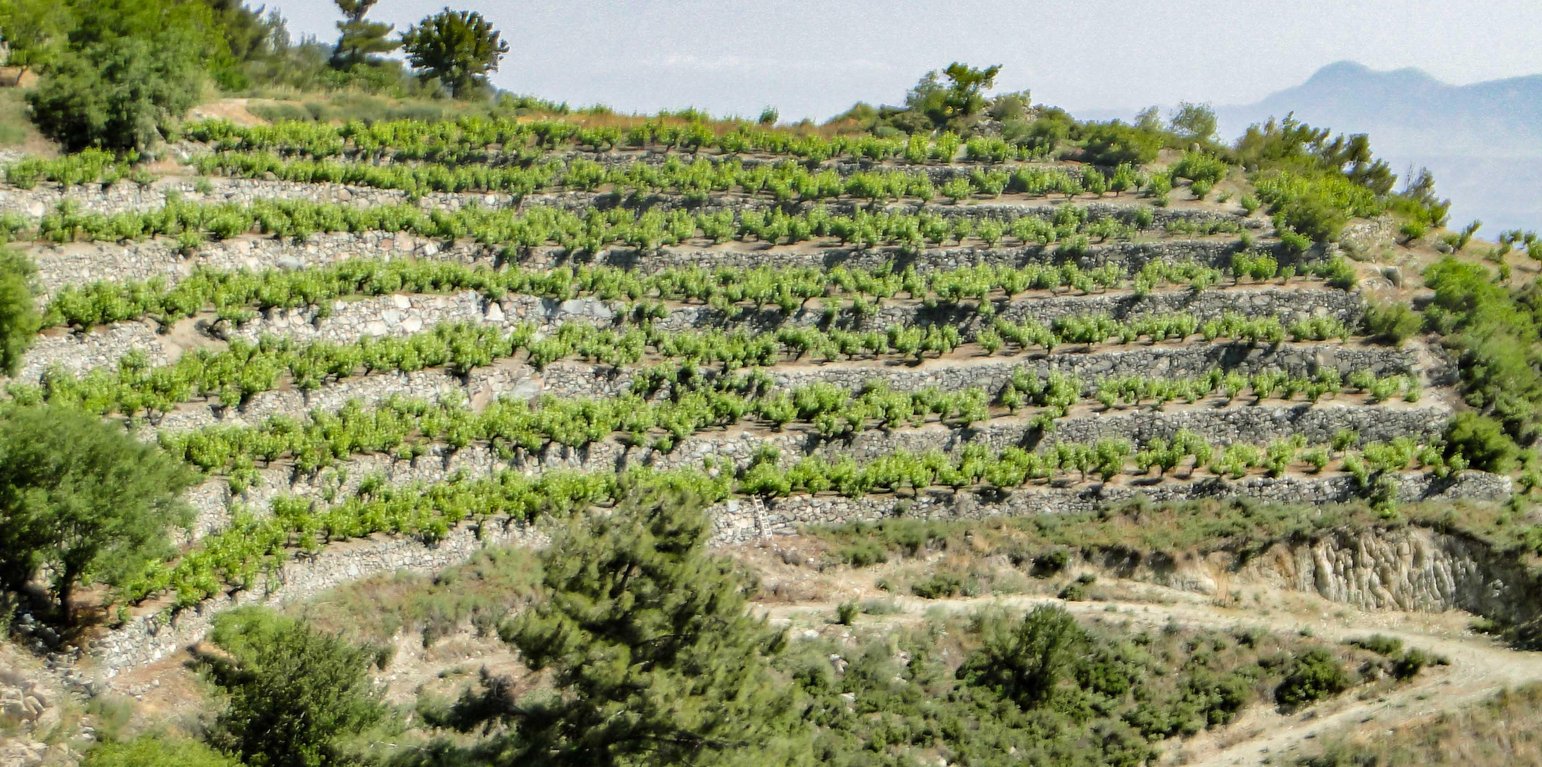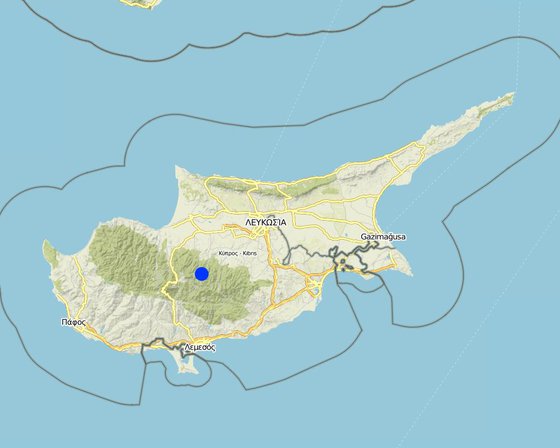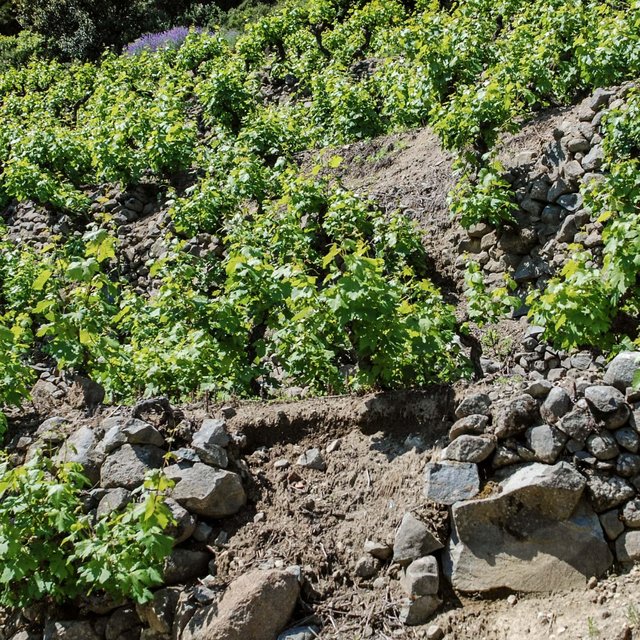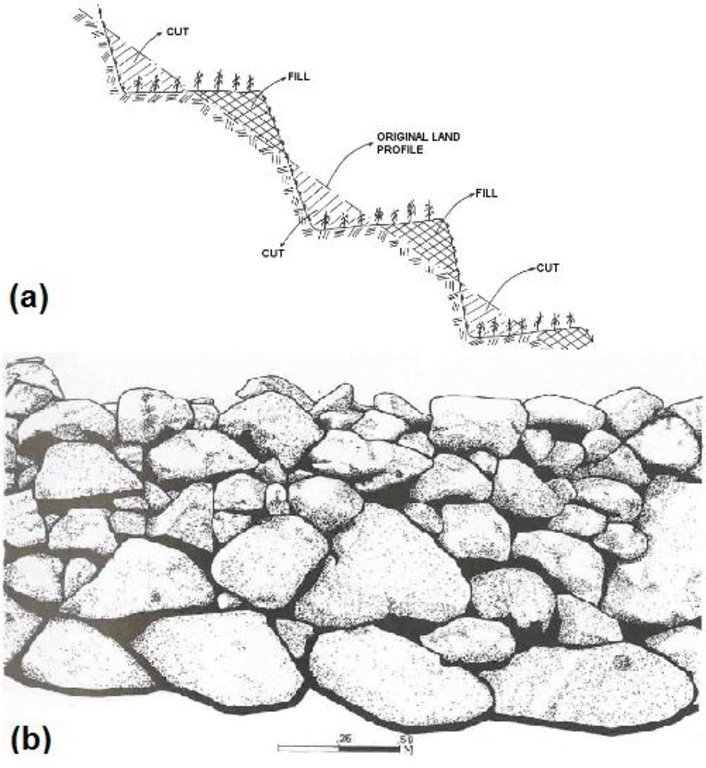



Dry-stone terraces consist of a series of nearly levelled platforms built along contour lines at suitable intervals. These structures characterise a large part of the landscape in Cyprus, and especially in communities around Troodos Mountains where large areas have been converted to agricultural terraces. The typical terraces found in the study-area are narrow (1-3 m) to medium-base (3-6 m) bench terraces, constructed by cutting and filling in slopes between 20-40%. The terraces are supported by walls, whereby stone is the only construction material without any binding mortar.
Terracing is one of the oldest means of cultivating slopes while saving soil and water. Due to the steep terrain of Troodos Mountains, the establishment of terraces acts as sediment trap storing the washed-off soil material within the slope. In general, terraces were created to stop or reduce the degrading effect of soil erosion by intercepting and controlling the surface run-off velocity and by facilitating its slower infiltration. In such a way, the sediment that accumulates behind the terraces has created suitable land for farming. In addition, the construction of dry-stone walls serves a dual purpose: to clear the land from large rock and stones, and to enhance the stability of the bench terraces against loss of top-soil. This is a type of technology that was very much used in the past and seen today as an important cultural landscape and heritage for these communities.
The construction of dry-stone walls was usually completed by the family who owned the field. Men undertook the building while the rest of the family carried the stones; assistance was also offered by relatives and friends of the family. First, the topography, the height and shape of the terrace is evaluated. Using a fuse, the craftsman shapes a straight line which would follow while building the wall. The foundations are created by excavating a pit of ~0.3-0.5 m, depending on the type of soils and the size of the wall; fuse, pick, mattock and shovel are the typical tools used. The pit is filled with large, irregular-shaped stones.
The stones are used in their natural shape for the construction of the walls without any processing. They are separated according to their shape, size and texture. The stones usually come from the cleaning of fields which will be cultivated or from a small-scale quarrying of the mountain slope using pick and lever. Large and irregular stones are used for the foundations, and the more regular ones for the construction of walls. The smaller stones are placed in between the large stones as the linchpin, to provide better stability to the structure.
The wall follows the land inclination and is laid over the foundation. Large stones are placed on the lower courses of the wall and on the exterior side. The stones are placed by hand one over the other, while smaller stones and rubbles are put between them in order to achieve more stability and better positioning; the stones cross both vertically and horizontally in order to avoid the creation of columns which will make the structure less stable. The wall is built lengthwise following the foundations and it reclines inwards; declination from the foundations does not exceed 5%. The back side of the wall is filled-up with more irregular stones which are not suitable to be placed on the front side. The filling connects the wall with the soil and stabilises the structure, and allows the drainage of water that is collected from the terrace and is discharged through the stones of the wall.
Terrace farming of grapes, nut and fruit trees, along with natural (mainly sclerophylous) vegetation constitute the predominant land uses in this area. The total population in the eight mountain communities of Peristerona Watershed has decreased by more than 50% over the past 30 years. The depopulation of mountain communities is associated with the urbanisation trends and the high farming costs which led to the gradual reduction of agricultural activities in the area. These socio-economic attributes form the main constraining factors for soil conservation. Thus, although terraces have a particularly beneficial effect in maintaining the productive capacity of soils in these communities, the significant changes in the socio-economic structure of the agricultural population over the last decades and the high maintenance and labour required, has led farmers to gradually abandon terrace farming. Consequently, many of the mountain terraces are no longer cultivated and dry stone walls are not maintained, causing sometimes a domino effect of collapsing terraces.

Байршил: Northeast Pitsilia, Nicosia, Кипр
Дүн шинжилгээнд хамрагдсан технологи нэвтрүүлсэн газрын тоо:
Технологийн тархалт: газар дээр жигд тархсан (30.9 km²)
Тусгай хамгаалалттай газар нутагт?:
Хэрэгжилтийн огноо: >50 жилийн өмнө (уламжлалт)
Нутагшууллын төрөл




| Зардлын нэр, төрөл | Хэмжих нэгж | Тоо хэмжээ | Нэгжийн үнэ (Euro) | Зардал бүрийн нийт өртөг (Euro) | Нийт дүнгээс газар ашиглагчийн төлсөн % |
| Хөдөлмөр эрхлэлт | |||||
| Labour | 4000.0 | 45.6 | 182400.0 | 100.0 | |
| Технологи бий болгох нийт үнэ өртөг | 182'400.0 | ||||
| Технологи бий болгох нийт үнэ өртөг, ам.доллар | 207'272.73 | ||||
| Зардлын нэр, төрөл | Хэмжих нэгж | Тоо хэмжээ | Нэгжийн үнэ (Euro) | Зардал бүрийн нийт өртөг (Euro) | Нийт дүнгээс газар ашиглагчийн төлсөн % |
| Хөдөлмөр эрхлэлт | |||||
| Labour | 200.0 | 9.12 | 1824.0 | 100.0 | |
| Технологийн арчилгаа/урсгал үйл ажиллагаанд шаардагдах нийт үнэ өртөг | 1'824.0 | ||||
| Технологи арчилах ба урсгал ажлын нийт үнэ өртөг, ам.доллар | 2'072.73 | ||||
Terraces create agricultural land for crop production in slopes. However, the establishment of terraces does not imply increased crop yield.
Without terraces on mountain slopes, crop farming would have been almost impossible
Well constructed and maintained terraces improve water drainage and retain soil moisture.
More costly to grown on mountain terraces than in the plains. Also, maintenance of collapsed terrace walls is costly.
Farming in the study-site is practiced almost exclusively on terraces; well maintained terraces can increase farm income.
Maintenance of collapsed terrace walls requires manual labour
Partly for those land users that still practice mountain terrace farming.
When terraces are maintained/rehabilitated through community-based activities.
When terraces are maintained/rehabilitated through community-based activities.
When terraces are maintained/rehabilitated through community-based activities.
Dry-stone terracing is the typical soil conservation technology in the study-site
Terraced landscapes in the Troodos mountains represent a longstanding tradition of self-sustained communities. In the past, terrace farming was a main activity and has contributed to the livelihoods and well-being of these communities. Nowadays, terrace farming is still practiced by much fewer land users, mainly on part-time basis.
One of the main functions of terraces.
One of the main functions of terraces.
When terraces are maintained
One of the main functions of terraces.
Dry-stone terraces create biodiversity habitats, especially for reptiles and arthropods
Well maintained terraces have less weeds than abandoned terraces, thus reducing the fire risk
Upstream terraces can reduce to a certain extent reduced downstream flooding
Upstream terraces can reduce to a certain extent downstream siltation
Well maintain terraces reduce damage (erosion) on public (e.g. roads) and private (e.g. neighbours fields) infrastructure